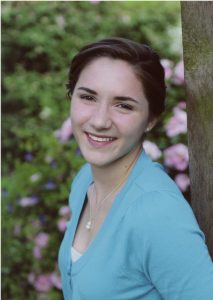Michelle Leslie and Shannon Smith both had applied for the Department of Defense’s Science, Mathematics and Research for Transformation (SMART) Scholarships before.
Leslie, a PhD candidate studying macromolecular science and engineering, applied twice as an undergraduate. Smith, a senior studying math and music, applied in her second year at Case Western Reserve University.
But neither let past disappointments deter them from trying again. It paid off: Both Leslie and Smith were awarded SMART Scholarships this year.
Case Western Reserve represented well in the SMART Scholarship competition this year, with four students receiving post-graduation jobs and funding for the remainder of their degree. (Diana Illingsworth and Lauren Anderson were the two other SMART Scholars in 2015.) Before this year, the university only had two winners since the scholarship’s inception in 2005.
Michelle Leslie
 Michelle Leslie attributes winning the SMART Scholarship this time around to networking. Last November, just before the deadline to submit her application, Leslie attended a meet-and-greet event for macromolecular science and engineering students at Case Western Reserve and struck up a conversation with someone who worked at the Wright-Patterson Air Force Base.
Michelle Leslie attributes winning the SMART Scholarship this time around to networking. Last November, just before the deadline to submit her application, Leslie attended a meet-and-greet event for macromolecular science and engineering students at Case Western Reserve and struck up a conversation with someone who worked at the Wright-Patterson Air Force Base.
That short conversation resulted in a mentor-mentee relationship, and also allowed Leslie to walk away with tips on how to bolster her application for the SMART Scholarship program.
When she received her scholarship offer, she realized her chance conversation paid off: Her placement would be at Wright-Patterson.
“I put myself out there,” she said. “I’m so unbelievably happy I did because I applied for this three times. I really want this scholarship.”
Working for the Department of Defense has been a goal of Leslie’s since she was an undergraduate studying chemistry at Virginia Tech. That’s when her dad told her about a Department of Defense materials scientist he met, and it piqued her interest.
“[His] job was to stay in a lab all day, light things on fire, shoot things and put things in water—that was a materials scientist,” she said. “I thought that was the coolest thing.”
Soon after, Leslie changed her major to materials science and engineering and made it her goal to conduct research to be used for military applications.
In her “dream job” with the Department of Defense at Wright-Patterson, Leslie will work in the materials and manufacturing directorate at the base, which means she’ll be part of a research group with one of three goals: development, application or push to market.
“To make a bullet-proof vest out of a polymer—that’s out of this world,” she said. “I want to be a part of that.”
Because earning her doctorate—and a post-graduation job—still is at least three years away, she hasn’t been placed in a particular research group and won’t know the full extent of her future job until the time nears. In the meantime, though, Leslie knows the program will help her to grow.
“The great thing about this scholarship is that they’re developing the person,” she said. “They’re investing in the student. They’re not investing in the student’s research—they’re investing in you.”
Shannon Smith
 For Shannon Smith, a few years and an impressive internship made all the difference in her application for a SMART Scholarship. After initially applying as a sophomore, Smith vowed to try again once she had more experience.
For Shannon Smith, a few years and an impressive internship made all the difference in her application for a SMART Scholarship. After initially applying as a sophomore, Smith vowed to try again once she had more experience.
During her 10-week internship at the United States Coast Guard Research and Development Center in New London, Conn., in the summer of 2014, she researched applications of underwater technologies for Coast Guard missions.
Just a year after missing out on the scholarship, she got another chance to apply as a junior and, this time, secured her future job and money to cover tuition for her final year of school.
“It was great to have the turnaround from my first time applying for the scholarship to this time, just knowing I have a job and other benefits to look forward to,” Smith said.
For Smith, who comes from a military family, working with the Department of Defense is a natural fit, even if it wasn’t always her intention.
“I was never really planning on joining the military, but this is my way of contributing,” she said. “The internship was a first step. It confirmed my thoughts of where I might head after graduation. The scholarship just sealed the deal.”
Smith will work with the Mission Engineering and Analysis branch at the Naval Undersea Warfare Center in Newport, R.I. While interning in Connecticut, she visited the base and was impressed by its operations, so she listed it as one of her top choices when applying.
At the Naval Undersea Warfare Center, she will run tests and problem-solve for the Navy, doing preliminary work so, ideally, the Navy won’t need to conduct extensive—and expensive—field tests.
Smith is only required to work at the base for one year, but she’d undecided on where she will go from there.
“I’m going to go into this year with an open mind and see how it works out,” she said. “I’m very open to staying longer.”
